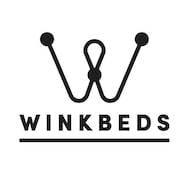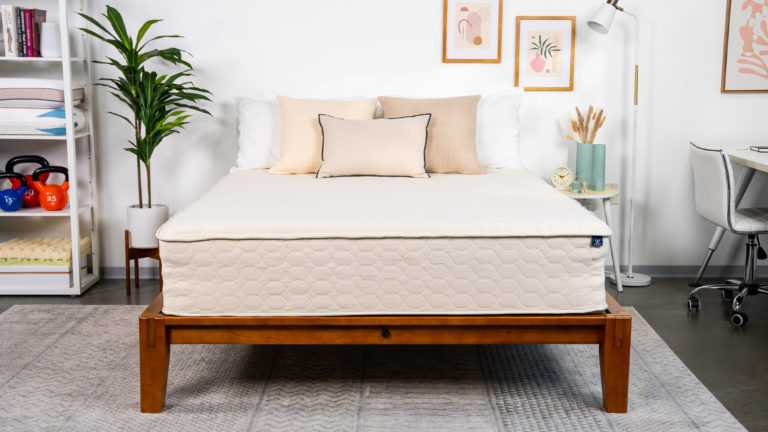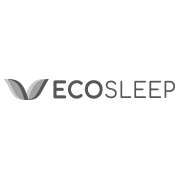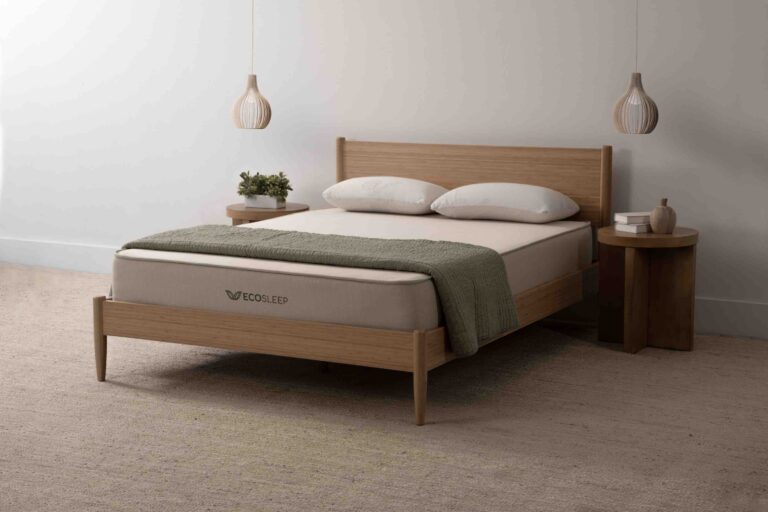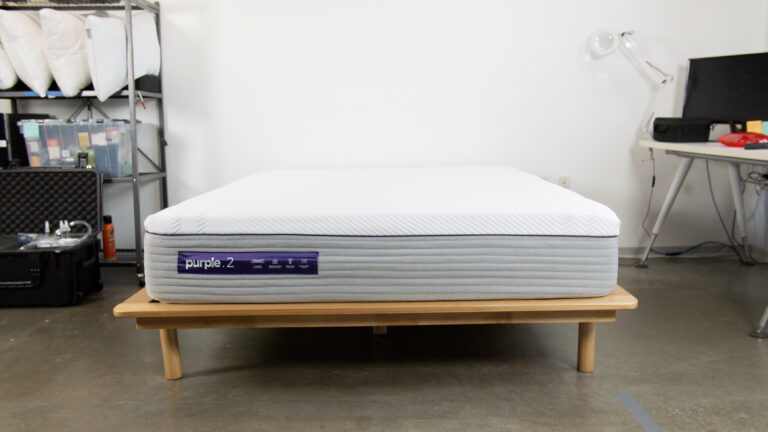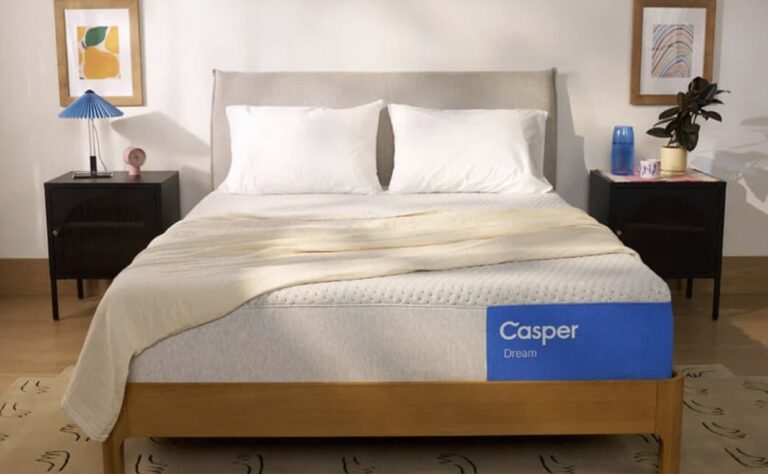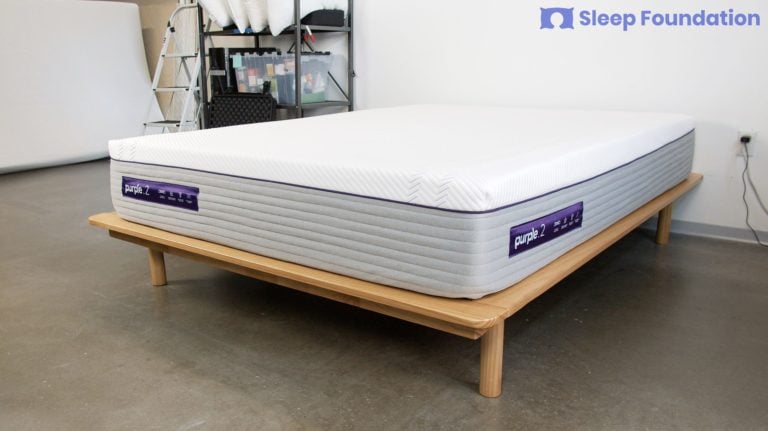When you buy through our links, we may earn a commission. Products or services may be offered by an affiliated entity. Learn more.
EcoCloud vs. EcoSleep Mattress Comparison
The EcoCloud and the EcoSleep are both latex hybrid models. The EcoCloud, manufactured by WinkBeds, has a high-profile design with ergonomic zoning through its latex and pocketed coil layers. The EcoSleep by Brooklyn Bedding is available in two options — the EcoSleep Mattress and EcoSleep Luxe. Each has a comparable design to the EcoCloud but is slightly firmer with a lower price tag.
The EcoCloud and EcoSleep may seem similar at first glance, as both pair Talalay latex with pocketed coil support cores. However, potential customers should be aware of differences in price, sizing, performance, construction, and policies.
Your unique sleep needs and preferences will determine whether the EcoCloud, the EcoSleep, or a different model is the right mattress for you. Comparing these two models head-to-head makes it easier to understand their differences and similarities as well as how factors like construction and design affect how both mattresses perform. By looking closer at major criteria, it’s possible to look beyond superficial similarities and decide between the EcoCloud and the EcoSleep with confidence.
Quick Look
We’ve worked hard to show you which of these models may be the best mattress for you. Check out our full mattress guides listed below.
$1,699
$1,295 – $1,327
Medium (5)
Medium Firm (6)
- Zoned latex and coils for better back support
- Reinforced perimeter support
- Lifetime warranty
- Made with eco-friendly materials
- Luxury features at a competitive price-point
- Supportive for all body types
- 120 nights (30-night requirement)
- Lifetime, Limited
- 120 nights (30-night requirement)
- 10 Year, Limited
Sizing Options
While the size of your mattress comes down to personal preference, certain factors may influence your decision. Smaller beds are less expensive and comparatively lightweight, but a sleep surface that’s too small can feel cramped and lead to sore muscles if you’re not able to stretch out. In comparison, larger sizes offer more room, but they are also more expensive and don’t always fit comfortably in small spaces.
Two other important size considerations are weight and height. Heavy mattresses can be difficult to move and may not suit some bed frames. However, they may feel more substantial. Height also frequently plays a role in mattress performance. People who weigh over 230 pounds often prefer the support of a thicker mattress. Additionally, some individuals find it easier to get out of bed if it is their preferred height. Shoppers should note, though, that high-profile models may require deep pocket sheets.
EcoCloud
EcoSleep
Height
12.5″Size Options
Twin, Twin XL, Full, Queen, King, California KingHeight
11.5″Size Options
Twin, Twin XL, Full, Queen, King, California KingHeight
11″Size Options
Twin, Twin XL, Full, Queen, King, California KingBoth the EcoCloud and the EcoSleep come in the same size options. If you’re looking for any of the standard bed sizes, this category will not narrow down your choice between the two models.
The EcoCloud is slightly heavier and thicker than the EcoSleep. These small differences are unlikely to be the deciding factor for most sleepers. That said, the EcoCloud may require deep pocket sheets due to its extra height.
WinkBeds Exclusive Offer!
Get $300 off all mattresses
EcoSleep by Brooklyn Bedding Exclusive Offer!
Ready to buy? Shop EcoSleep by Brooklyn Bedding mattresses
Construction and Materials Comparison
How a mattress performs comes down to its materials and construction. Seemingly minor variations can make surprisingly significant differences, so examining the details may help you determine which mattress is right for you.
The EcoCloud and the EcoSleep are latex hybrid models. Each model uses natural Talalay latex made from rubber tree sap in its comfort system. This material tends to be softer and more breathable than Dunlop latex.
Beneath the comfort system is a support core, which stabilizes the entire mattress while providing whole-body support. Like many hybrid models, the EcoCloud and the EcoSleep use pocketed coil support cores in which individual springs are not connected. Instead, they are wrapped in fabric and compress individually, which can enhance durability, motion isolation, and pressure relief.
EcoCloud
At 12.5 inches, the EcoCloud stands taller than the average mattress. It has a cover made from a blend of New Zealand wool and GOTS-certified organic cotton. This breathable and moisture-wicking combination helps combat heat retention.
The EcoCloud’s 4-inch comfort system consists of two layers of natural Talalay latex certified by the Rainforest Alliance. Both layers use aerated latex with a pinhole design meant to enhance the mattress’ temperature neutrality with better airflow.
A convoluted top layer is designed for airflow and pressure relief. It has a softer feel that contours more closely than most latex layers, although it does not hug the body like memory foam. The second layer is firmer overall with multiple zones offering targeted support for different areas of the body. For example, the area around the shoulders is less firm than the lumbar region. This ergonomic zoning is intended to alleviate pressure points in sensitive areas while still providing substantial back support, which makes it a great mattress for people with back pain.
An 8-inch pocketed coil core serves as the support system. The coils are made of recycled steel and have been tempered three times for greater durability. Zoning provides targeted support in the mattress’ midsection to promote good posture. The perimeter is also reinforced to limit sagging when you sit or lie on the edge. This support makes it easier to sleep close to the side without feeling as though you might roll off.
The EcoCloud’s construction gives it a medium feel, which equates to 5 out of 10 on the firmness scale. It contours more closely to the body than other latex models while still offering enough support to make most people feel like they are sleeping on, rather than in, their bed. Mattresses with a medium feel tend to have fairly broad appeal, and the EcoCloud is no exception. However, sleepers who weigh over 230 pounds may be more comfortable on a firmer bed.
EcoSleep
The EcoSleep Luxe and EcoSleep Mattress are 11 and 11.5 inches tall, respectively, and wrapped in a cover made from GOTS-certified organic cotton to help regulate moisture and temperatures. Both have a medium firm (6) feel that many people should find supportive.
The EcoSleep Mattress has a comfort system featuring wool batting over several inches of latex. The EcoSleep Luxe’s comfort system is composed of two wool layers, one including cashmere, followed by a latex layer. Both models compress enough to contour to the body while providing more bounce and breathability than most synthetic foam, although the Luxe offers a bit more cushioning due to the extra wool.
Both models feature an 8-inch pocketed coil support core. This system adds bounce, breathability, and deep compression support while limiting motion transfer. The Luxe model is zoned to enhance support and pressure relief where they’re most needed. Side sleepers between 130 and 230 pounds and back sleepers up to 230 pounds may prefer the Luxe for its slightly more cushioned surface, while side sleepers over 230 pounds may gravitate toward the non-Luxe version.
Pricing Information
Mattresses are a significant investment, but finding a suitable new bed without breaking the bank is possible. While it is essential to choose a comfortable and supportive mattress, the most expensive option is not always the best for your needs.
Prices vary significantly based on a range of factors. The most significant variables are mattress type (such as all-foam, innerspring, hybrid, or latex), size, materials, and unique features or design elements. More complex mattresses, such as a hybrid model with an innovative design or proprietary materials, are generally more expensive than simpler models, like a basic all-foam or innerspring bed. Mattresses made from natural materials are also typically more expensive than their synthetic counterparts.
Other construction variables that affect the price of a mattress include the quality of its workmanship and materials, where the bed was manufactured, and the use of organic components. These factors may be more or less important to you depending on your needs.
Additionally, some mattresses may cost more for reasons that do not impact their performance or quality, such as the manufacturer’s marketing costs or the expense of maintaining brick-and-mortar locations.
When considering the total cost of a mattress, customers should also keep in mind additional expenses they may incur, such as shipping charges, taxes, old mattress recycling fees, and the cost of any accessories they plan on using with their new bed.
EcoCloud
Sleep Foundation Special Offer
Get $300 off all mattresses at Winkbeds
EcoSleep
Sleep Foundation Special Offer
Ready to buy? Shop EcoSleep by Brooklyn Bedding mattresses
Both the EcoCloud and the EcoSleep are priced below the average cost of latex and hybrid models. Natural latex typically costs more than synthetic foam, while hybrid designs are more complex than standard all-foam or innerspring mattresses. The EcoCloud and the EcoSleep also both feature organic cotton and natural wool, raising their price compared to some beds that use synthetic fabrics or non-organic cotton.
Due to the EcoCloud’s more complex construction and added thickness, it carries a slightly higher price tag than the EcoSleep.
The EcoCloud’s latex comfort system and coil core are zoned for improved pressure relief and support in areas like the hips and shoulders, adding to the cost. However, the less-expensive EcoSleep models perform comparably at a significantly lower cost. Both mattresses fared very well in key categories, so which option is the better overall value will likely depend on the customer’s needs, preferences, and priorities.
Mattress Performance Ratings
There’s no such thing as a one-size-fits-all mattress, and it’s rare for a single model to excel in all performance areas. Among the many characteristics that determine mattress performance, your preferences and unique needs will determine which attributes you should prioritize. By focusing on the features that matter most to you, the mattress search becomes much easier.
The easiest way to compare mattresses is by breaking down their performance into a range of categories. This process makes it easier to understand how a mattress’ design and features translate to real-life use. Individual categories may also be more or less important to different customers. No single mattress is perfect for everyone. It’s crucial to focus on your unique needs and preferences when weighing how different mattresses perform.
Durability
A mattress’ durability depends on its workmanship and materials. Beds made from high-quality components tend to be more durable than those made from lower-quality alternatives. However, even durable materials may soften with age, though they should resist indentations and degradation that significantly limit their lifespan.
Motion Isolation
This category refers to whether or not movement transfers across the mattress when one person changes position, rolls over, or gets out of bed. A mattress’ ability to absorb vibrations is based mostly on its construction and materials. All-foam mattresses traditionally offer significantly better motion isolation than innerspring models. Hybrid mattresses, including latex hybrids, tend to be somewhere in the middle. However, differences in construction can also cause some models of the same type to perform better than others.
Sex
Mattresses that are conducive to sex tend to be bouncy and supportive with considerable ease of movement and good edge support. Highly contouring materials in the comfort system, such as memory foam and some polyfoam, are usually less popular with couples than responsive materials like latex. A mattress’ support core also plays a role. Hybrid and innerspring beds usually rate higher than models with foam cores since springs provide extra bounce.
Temperature Neutrality
Even people who are prone to getting cold during the night usually prefer a bed with excellent temperature neutrality, but this category is often most important for those who tend to sleep hot. A bed that performs well in this area maintains a comfortable sleeping temperature throughout the night, often due to good airflow.
Some mattresses, such as those made with memory foam, tend to trap heat. Other materials, like latex, wool, and coils, are naturally more temperature neutral. However, manufacturers continue to improve on designs, so temperature regulation can differ dramatically between mattresses of the same type.
Pressure Relief
A mattress with good pressure relief distributes your weight evenly, preventing uncomfortable pressure points and offering a more comfortable sleep experience. Highly contouring materials like memory foam tend to perform very well in this category, but a mattress doesn’t have to conform closely to the body to relieve pressure. Latex, for example, offers pressure relief without hug thanks to its elastic qualities.
Off-Gassing
The off-gassing of volatile organic compounds (VOCs) can cause odors when the mattress is first unboxed. VOCs are created by the manufacturing process and are thought to be mostly harmless. Your new mattress smell should dissipate within a few hours to a few days. However, the type of material can impact the duration and intensity of the odor. Synthetic foams, for example, tend to off-gas more than other mattress components.
Ease of Movement
People who change positions throughout the night or who have mobility concerns may want to choose a bed with good ease of movement. Materials that contour closely to the body can restrict movement, while those that are more responsive may aid it. However, some close-conforming mattresses find a balance by including a responsive transition layer and/or support core. The depth of the bed’s comfort system also plays a role since it influences how deeply you sink in.
Edge Support
Mattresses with good edge support allow you to sit and sleep close to the perimeter without worrying about sagging. Couples and people with mobility concerns tend to prefer sturdy edge support since it makes it easier to use the full mattress surface.
Edge support is partially dependent on the mattress type. A foam support core is usually less stable around the perimeter than a pocketed coil core. However, perimeter reinforcement, a thinner comfort system, and/or a firmer feel can contribute to better edge support for any type of mattress.
EcoCloud
EcoSleep
Trials, Warranty, and Delivery
WinkBeds
Sleep Trial & Returns
120 nights (30-night requirement)
Warranty
Lifetime, Limited
Shipping
Free to contiguous U.S.
EcoSleep by Brooklyn Bedding
Sleep Trial & Returns
120 nights (30-night requirement)
Warranty
10 Year, Limited
Shipping
Free to contiguous U.S.
Shipping
While it is rarely the main factor customers use to choose their mattress, a company’s shipping policies can affect the overall convenience and expense of the purchase. Most mattress in a box companies offer free to-the-door delivery within the contiguous United States. For this shipping method, the mattress is compressed and wrapped in plastic before being placed in a cardboard box. The new owner is responsible for bringing the mattress into their home, unpacking it, and allowing it to decompress.
Some mattress companies also offer other shipping services for an additional fee, which is non-refundable. Many companies ship to Alaska, Hawaii, and Canada, and some can expedite shipping. White Glove delivery may also be available. This provides a team to deliver and set up your new mattress. It also frequently includes old mattress removal.
EcoCloud Shipping Policies
WinkBeds, the maker of the EcoCloud, offers free shipping to locations in the contiguous United States. A $199 charge applies to orders to Alaska and Hawaii, and shipping to Canada is not available at this time. Orders typically ship via UPS, and most customers within the contiguous U.S. receive their mattresses within 7 to 14 business days.
EcoSleep Shipping Policies
EcoSleep’s parent company, Brooklyn Bedding, ships for free within the contiguous U.S. states via FedEx, while customers in Alaska and Hawaii pay a $125 shipping charge per mattress. The EcoSleep is also available to Canadian residents, who incur a shipping fee starting at $250. Most customers receive their EcoSleep Mattress within 5 to 8 business days, although customers in Alaska, Hawaii, or Canada should be prepared for a longer wait.
Sleep Trial and Returns
Since customers often don’t have an opportunity to try out direct-to-consumer mattresses before buying, most manufacturers offer a sleep trial that provides a return window during which the new owner can return their mattress if they aren’t satisfied. Most sleep trials last around 100 days. Some companies will ask that you donate the unwanted mattress and provide proof to receive a refund, while others may require return shipping. Very few ask that customers return the mattress in its original packaging.
Mattresses usually must remain in good condition to be eligible. Initial shipping charges are non-refundable and additional fees may apply. Households are typically eligible for just one sleep trial, though some companies offer one trial period per year.
EcoCloud Sleep Trial and Return Policy
The EcoCloud Mattress comes with a 120-night sleep trial that begins the day your mattress arrives. Customers must try the mattress for at least 30 nights to adjust before initiating a return.
Those who wish to return their EcoCloud Mattress should contact WinkBeds, the manufacturer. WinkBeds will handle the rest of the return process, including coordinating the pickup of the mattress for donation or recycling. Customers can also pay a $49 recycling fee to exchange their EcoCloud for a different model. The replacement mattress comes with a 60-night sleep trial and arrives before your previous mattress is removed.
EcoSleep Sleep Trial and Return Policy
EcoSleep Mattress customers can take advantage of a 120-night trial period. Once the buyer has tried the mattress for at least 30 nights, it becomes eligible for return. EcoSleep’s manufacturer, Brooklyn Bedding, requires customers to initiate the return process by contacting customer support. The representative may suggest solutions to modify the existing mattress, such as adjusting the support or adding a topper. If the customer still isn’t satisfied, Brooklyn Bedding accepts exchanges and returns.
In most cases, the company asks that you donate your unwanted mattress to a local charity and provide a receipt, but it will help coordinate pickup if necessary.
Warranty
Like other big purchases, most mattresses come with a warranty policy to protect the original purchaser if the product is defective. Mattress warranty policies vary a great deal in their length, covered defects, and remedies, so customers should review the policy before purchase for a clearer idea of what it entails.
Most mattress warranties cover cracking, splitting, and indentations over a certain depth. The customer may incur shipping charges or prorated fees for making a claim, and the manufacturer will determine whether to repair or replace the mattress if it determines there is an eligible defect.
Warranties typically exclude damage due to an improper foundation, misuse, abuse, and improper care.
EcoCloud Mattress Warranty
WinkBeds offers EcoCloud owners a limited lifetime warranty that covers certain manufacturing and material defects. Customers taking advantage of the warranty must pay shipping charges to return their mattresses to WinkBeds for inspection. If the company determines your mattress is defective, it will reimburse all shipping fees and replace your mattress.
The warranty covers lingering impressions deeper than 1.5 inches as well as material degradation, such as splitting or cracking. For your bed to qualify for replacement, these defects must not be caused by improper use or support.
EcoSleep Mattress Warranty
Brooklyn Bedding backs the EcoSleep with a 10-year limited warranty covering qualifying manufacturing and material defects, including lingering impressions deeper than 1 inch, sagging, and splitting or cracking latex.
If you have not supported your mattress correctly or if the damage occurs after incorrect use or handling, your mattress will not be eligible for coverage. Ordinary changes to the mattress, such as the latex softening over time, are not considered defects. Mattresses deemed to be in unsanitary condition may be ineligible for repair or replacement.
If Brooklyn Bedding determines that the mattress has a defect that qualifies for coverage, it will elect to either repair or replace the mattress.

Still have questions?
Our product experts have extensive experience testing just about every sleep product on the market. Send an email to [email protected] or call us at (877) 672-8966 with your questions and we'll help you find exactly what you're looking for.

